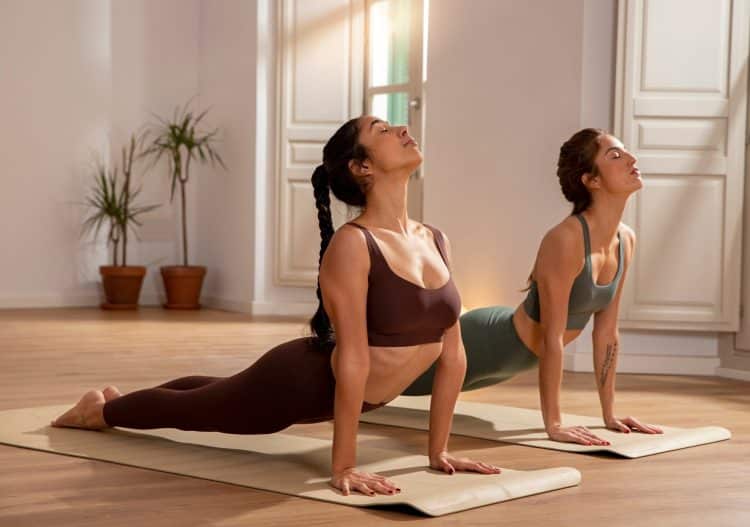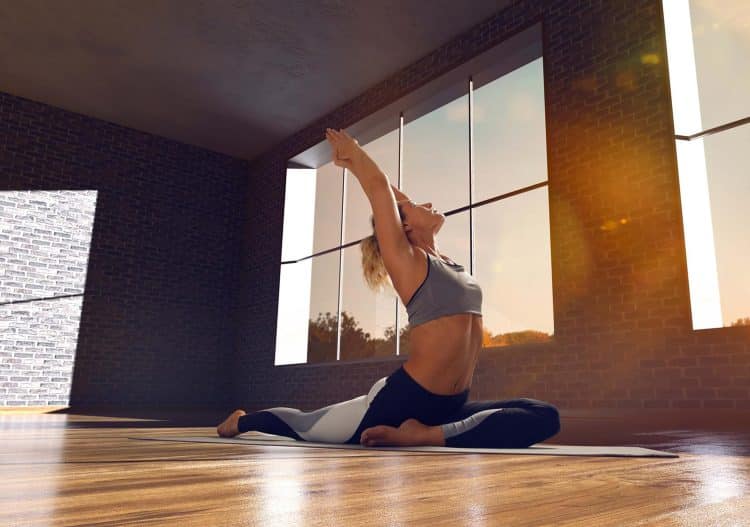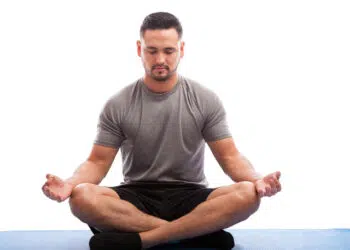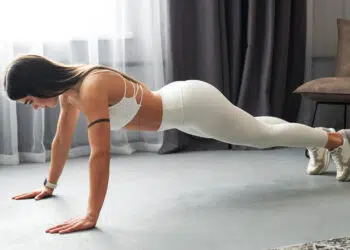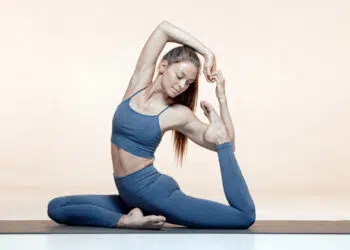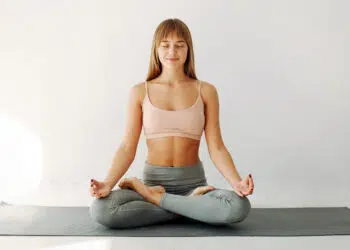You’ve been curious about Bikram Yoga and have decided to take the plunge. You step into a well-heated studio space – 105°F (40.6°C) to be exact. You roll out your yoga mat and you’re already beginning to feel the beads of sweat form on your forehead. You question your decision to try a hot yoga class, but you remain committed. You’re ready to endure the experience.
This is, perhaps, how many have begun their Bikram Yoga journey. An opportunity to partake in a style of yoga that has been known to build physical and emotional strength, gain mental clarity, to develop a strong mind-body connection, all while leaving a puddle of sweat on the yoga mat.
This article is designed to be a hot yoga guide. We intend to answer the questions you may have about this unique form of yoga practice so you can decide whether or not it is the type of yoga for you. It will provide the following if you, too, are curious about the world of Bikram Yoga:
- What Is Bikram Yoga?
- The History & Origin of Bikram Yoga
- The 26 Postures of Bikram Yoga
- Bikram Yoga for Beginners
- The Benefits of Bikram Yoga
- How to Prepare for a Bikram Yoga Class
- What To Do After Your Practice
If this has begun to pique your interest and you’re curious about the world of Bikram Yoga, then let’s get started!
What Is Bikram Yoga?
It’s always a good idea to start with a definition of this style of yoga: What IS Bikram Yoga? Where did it come from? First of all, it isn’t the stereotypical form of yoga that many conjure in their minds when they think about practicing yoga. Don’t expect to sit quietly in a dimly candlelit room with incense burning while chanting to the sound of crystal bowls. Quite the contrary. This is an immersive yoga experience in which you will endure 26 fixed yoga postures and practice specific breathing techniques. This is all done, of course, in a heated yoga studio, so be prepared to move and sweat.
Each yoga pose has a purpose: you are in class to target and challenge many aspects of your physical and mental well-being. The heat of the room only represents the environmental component of the yoga space. It is what you do with your mind and body during the heated class that allows for potential growth along with a myriad of other benefits. Before we dive deeper into the nuances of Bikram Yoga, let’s take a journey to India to discover its history and origin.
Level Up Your Fitness: Join our 💪 strong community in Fitness Volt Newsletter. Get daily inspiration, expert-backed workouts, nutrition tips, the latest in strength sports, and the support you need to reach your goals. Subscribe for free!
The History & Origin of Bikram Yoga: From Calcutta to Hollywood
Let’s step back in time to the mid-20th century – the late 1940’s to be more precise. A boy by the name of Bikram Choudhry was born and raised in the town of Calcutta (now called Kolkata).
At a young age, Bikram struggled with some physical issues; he had suffered a knee injury which resulted in chronic pain. He was determined to find healing so he could feel relief from this excruciating pain. He first turned to conventional medical options to find relief but was met with a host of shortcomings and no long-term relief.
Bikram was also a student of yoga. He turned to his teacher, Bishnu Charan Ghosh, to find further education and guidance. Bikram was determined to find complete healing from his physical pain through the philosophy of yoga. He devoted his studies to the yogic texts and ancient teachings related to yoga. He discovered the inner workings of how the body, mind, and spirit are all connected. Rather than just focusing on the physical body to find healing, he gained insight into the fusion of all these elements to experience true healing. In addition to his knowledge about the traditions of yoga, like The Eight Limbs, he incorporated scientific research to compose a more relevant form of overall health and well-being.
Now with his knowledge of philosophy and science, Bikram weaved together yoga postures, breathwork, and meditation (aspects of The Eight Limbs of Yoga) to form what we now know as the 26 fixed posture series of the Bikram Yoga practice. He did not make up the poses himself. No, he designed a logical yoga sequence from a list of more than 500 already existing yoga poses to create his now-famous healing practice. When one takes a Bikram Yoga class, the signature series takes about 90 minutes to complete. The 26 posture series, accompanied by two Pranayama (breathing) exercises, systematically engages the muscles, joints, and organs of the entire body.
By the late 1960s, not only had Bikram Choudhry found personal relief and healing in his own body, but had crafted a fine-tuned yoga practice that he later marketed to the world. His classes, of course, were not like any other. There was something certainly different about this series of movements and breath – the heat! Why is Bikram Yoga practiced in a hot studio?
The heat and humidity in a Bikram Yoga studio are intentional. It is designed to warm up the muscles of the body and enhance the elasticity of the ligaments to release bond-up connective tissue. A yogi performing asanas (yoga postures) in a 105°F (40.6°C) room experiences greater flexibility throughout their body for improved mobility, strength, and detoxification. The intention is to create physical relief and healing.
But Bikram’s deeper goal was to help people not only find physical health, but mindful, emotional, and spiritual healing through this form of yoga practice.
In the 1970s Bikram brought his new style of yoga to the United States. It rapidly stole the hearts, minds, and bodies of the Hollywood elite. Beverly Hills became the landmark for The Bikram Yoga American debut. It attracted celebrities and athletes from all over. Early well-known individuals like Raquel Welch and Shirley MacLaine took to their yoga mats to sweat it out the Bikram way. In more recent times, the likes of Lady Gaga and David Beckham could be seen entering a Bikram Yoga studio.
Although Bikram Yoga attracted the star-studded crowd, this form of yoga was designed for everyone to practice. Bikram’s intention was to create a practice for those willing to embrace a physical and mental challenge. The result – find healing in their bodies and strive toward their highest potential mentally, emotionally, and spiritually.
The 26 Postures of Bikram Yoga: Why Are They So Special?
At first glance, the individual postures in the Bikram Yoga series may seem ordinary. Can’t one practice these exact same postures in other yoga classes? Absolutely – but it is the unique and highly tuned combination of these 26 fixed postures that are the backbone of this hot yoga style. This collection of yoga poses is far from ordinary – they are, in fact, nothing short of revolutionary. They are considered the gateway to a holistic transformation that begins on the yoga mat but reaches limitless boundaries off the mat.
As a Bikram Yoga student, you will start with the Standing Deep Breathing Pose. You’ll embark on postures like Awkward Pose, Camel Pose, and other positions throughout the fixed yoga series. The intention is to not simply bend and stretch. The intention is to push your boundaries, ride your personal edges, cultivate inner and outer strength, and gain flexibility, mobility, balance, and healing. Each posture tells its own story, but as a whole collective, contributes to overall development and growth.
To elaborate on this idea, let’s take a closer look at the three Bikram Yoga poses mentioned above:
Standing Deep Breathing Pose
Your Bikram Yoga journey begins in a standing position with this intricate breathing exercise. Like all other breathing methods in other styles of yoga, this practice establishes deep connection, awareness, and focus.
Breathing, in general, is not just about the inhale and the exhale. It is about invoking Prana (the life force energy) into your entire body. Each breath is intentional and a strong reminder that the remainder of your hot yoga practice is more than just a physical exercise.
The Standing Deep Breathing practice calms your nervous system, improves the cardiovascular system, and enhances mental focus and physical coordination. You are establishing a solid foundation by generating internal heat and oxygen flow to endure your yoga practice.
Awkward Pose
Awkward Pose (or Utkatasana in Sanskrit – the language of yoga) is the third Birkam Yoga pose performed in the series. Sometimes known as “Chair Pose” in other forms of yoga, you are not taking a seat to relax. Instead, the focus is on your legs to warm them up and develop strength as you continue through the practice. You engage the major muscle groups of your lower body: hips, hamstrings, glutes, and quads. By focusing on the strength and stability of your legs, you refine agility, muscle control, and balance to further support your practice.
Bikram purposefully renamed this posture, not to highlight the difficulty or awkwardness of this yoga position, but to embrace the uneasy, unpredictable, and unsteady circumstances in our everyday lives. It is a reminder that life isn’t always a piece of cake. In fact, it teaches us that deep and personal growth develops from enduring life events that push out well out of our comfort zones. Awkward Pose, therefore, is an invitation to step into the unsteadiness, only to discover practical means to manage the hardships in our lives.
Camel Pose
The physical aspect of Camel Pose focuses on arching your back to create a backbend. By opening the whole front side of your body, you aid in developing more flexibility, mobility, and strength along your spine. But Camel Pose is much more than just a backbend.
In yoga, backbends are considered heart openers – Bikram consciously added this pose to his series to practice vulnerability and openness. He believed, like other yoga teachers, that bottled-up emotions contribute to ill health in the mind and body. Instead of keeping the cap on that bottle (that will eventually erupt), you are encouraged to face the difficult circumstances in your life. If we are able to accept the challenge of this heart-opening backbend, then you’ll be able to approach your outside environment, also, with a sense of ease and calm.
These are just 3 of the 26 yoga postures in the Bikram Yoga series. By understanding the nature, story, and intention of each pose, you, the yoga practitioner, have the capability to fully internalize the physical, mental, and emotional benefits of this revolutionary form of yoga.
Bikram Yoga for Beginners: Is it Right for YOU?
Well, if Lady Gaga and Madonna practice Bikram Yoga, is it necessarily right for you? What if you’re a beginner? As Bikram originally intended, this style of yoga was designed for anyone wanting to pursue development, growth, healing, and happiness in their lives. If that’s what you’re wanting in YOUR life, then continue reading. Bikram Yoga can be a yoga practice for you, even if you’re a beginner.
Sure, walking into your first yoga class can feel quite intimidating, but know that you already did the hard part – you showed up! There are certainly ways to physically and mentally get ready for a Bikram Yoga class (feel free to skip ahead to the section “How to Prepare for a Bikram Yoga Class”) but let’s first answer some fundamental questions about Bikram Yoga to determine whether or not it is right for you.
- Is Bikram Yoga Safe?
- Do You Already Need to Know How to Practice Yoga?
- How is Bikram Yoga Different from Hot Yoga?
- How Often Should You Practice?
- Who Shouldn’t Do Bikram Yoga?
Is Bikram Yoga Safe? (It seems so hot!)
Yes, I IS hot and it IS safe, but only if you approach the practice mindfully. Know that not everyone can tolerate extreme heat, especially when performing high-energy exercise. There is a risk of heat exhaustion, dehydration, and other serious health concerns. It is ALWAYS best, regardless of the style of yoga practice you choose, to consult with a healthcare provider. Determine whether or not you are physically capable of enduring this form of exercise.
Extend that communication with your yoga instructor. Share any health concerns with the instructor along with the fact that you are new to Bikram Yoga. By doing these things, you are ensuring a safe experience for yourself. Remember, yoga is about being mindful, connected, and aware of yourself. Yoga is about taking care of yourself. There is no need to produce personal harm when trying something new like a hot yoga class. Instead, listen to your body and pursue your practice with a sense of self-preservation as a foundation for further personal growth and transformation.
Do You Already Need to Know How to Practice Yoga?
It may help to have a basic understanding of some yoga, but you can certainly attend Bikram Yoga as your first style of yoga practice. Talk to your instructor, and let them know you are a beginner. They will be able to help you and offer modifications of poses as you continue you develop a personal practice.
It is perfectly fine to modify your poses and practice alternative ways to do a yoga pose that fits your body and current physicality. Take breaks during class to reduce any health risks or injury. Yoga is a journey – be patient. You may not be able to do all the poses perfectly the first time. That is not the goal. The goal is to seek and find your own limitations, acknowledge and honor them, and further discover your strengths. Yoga is an evolution; as you develop a consistent yoga practice, you will surely grow and aspire to your greatest potential.
How is Bikram Yoga Different from Hot Yoga?
We have discussed the point that Bikram Yoga is a hot yoga practice. You may have seen yoga studios that offer Hot Yoga. Is it the same as Bikram Yoga?
Level Up Your Fitness: Join our 💪 strong community in Fitness Volt Newsletter. Get daily inspiration, expert-backed workouts, nutrition tips, the latest in strength sports, and the support you need to reach your goals. Subscribe for free!
Bikram Choudhry certainly inspired many to try his style of yoga. It even inspired other teachers of his caliber to develop their own interpretations of hot yoga to inspire more yogis. While Bikram Yoga is hot yoga, not every hot yoga class is Bikram Yoga. Let’s clarify.
In other classes titled Hot Yoga, yes, you WILL be practicing among other sweaty yogis in a heated studio. The sequencing of the poses, though, is quite different. You may encounter some of the original 26 yoga postures of Bikram Yoga, but the Hot Yoga instructor may take the liberty to mix up the series, add to, or even subtract from the fixed standard. Others may also add music or a Vinyasa (flow/dance) style of movement in their hot yoga sessions.
To get the true Bikram Yoga experience, you’re encouraged to attend a class in a certified Bikram Yoga studio. Do your research by checking online for Bikram Yoga studios in your neighborhood.
How Often Should You Practice?
As a beginner, perhaps start with once or twice a week to help acclimate to the demand of practicing yoga in extreme heat. As you adjust, increase to two or three times a week. It’s a good idea to take breaks between sessions to allow your body to recover.
Who Shouldn’t Do Bikram Yoga?
If you have any injuries or health concerns, or if you are pregnant, then you may want to step lightly into a Bikram Yoga class. Either consult with health professionals and yoga instructors first or perhaps choose another yoga route to meet your destination. And it probably goes without saying, that children may not be the best candidate for Bikram Yoga.
The Benefits of Bikram Yoga: Why Do Bikram Yoga?
Putting some of the risks and concerns aside, Bikram Yoga is a unique yoga practice that offers many benefits. Let’s explore some of the advantages of rolling out your yoga mat and donning a sweatband.
Enhanced Flexibility & Range of Motion
As mentioned earlier, because Bikram Yoga is done in a heated yoga studio, it can enhance your flexibility. If you have tight hamstrings or lower back, the heat will warm up your muscles – they become more pliable. This will allow you to stretch your body more efficiently and move into yoga postures with great depth. As you develop a consistent practice, you will notice that your range of motion overall will greatly improve.
Gain Strength From the Inside Out
Not only will you experience more flexibility and mobility from a Bikram Yoga practice, but you will also gain more strength throughout your body. The 26 postures will have you engaging muscles you didn’t know existed. (Yes, you may be sore after your first few yoga sessions.) Because of the demanding sequence of poses, you engage your core – this results in a stronger body overall. You can also think of your yoga practice as a comprehensive workout that will sculpt and tone your body as you develop strength in your bones, ligaments, joints, and muscles.
Mental Clarity & Focus
It may seem counterintuitive to think that a Bikram Yoga practice fosters calm and ease in your mind. How do you have time to focus when you’re sweating all over your yoga mat? The high heat and challenging postures are intentional – they allow you to navigate through these physical and mental challenges only to learn ways to manage hardship, misfortune, and discomfort. As you are training your body, you are also training your mind.
The intense heat demands your attention to manage extreme elements. You learn how to remain present and centered so you can work through difficult situations and external distractions. As a result, you develop the mental capacity to remain disciplined and in control of your reactions. These lessons begin on the (sweaty) yoga mat but transcend off the mat into your life outside the studio. You’ll find the ability to approach daily tasks with heightened clarity, mindfulness, ease, and grace.
Stress Reduction
With consistent practice, Bikram Yoga enhances the ability to reduce stress. Physiologically, your body shifts from activating the Sympathetic Nervous System (the Flight or Fight Response) attributed to stress, to the Parasympathetic Nervous System which is related to the Rest & Digest Response. We all can benefit from less stress and anxiety in our lives. Practicing yoga has been scientifically proven to soothe your nervous system and reduce stress which can sometimes lead to unfortunate health concerns.
Detoxification
The high heat in your Bikram Yoga class assists with the detoxification function in our bodies. Think of the elevated heat as a signal for your body to release toxins through your skin as you sweat and help purify your organs like your liver and kidneys. The result is a restoration of cell development, transportation of oxygen and blood, and promotion of overall health and vitality that aids in the body’s natural process for healing.
Weight Management
People often ask if practicing Bikram Yoga helps with losing weight. In some cases, it can. However, you may not want to approach this practice with the primary intention of losing weight. Weight management is a byproduct of practicing Bikram Yoga. The heat-induced yoga studio will raise your heart rate thereby potentially increasing your calorie burn. This can, for some, result in weight loss. If losing weight or even maintaining your current weight is a goal for you, Bikram Yoga can support your fitness intentions. Be sure, though, to combine your efforts with a balanced diet and other healthy lifestyle choices that suit your needs.
As you can see, Bikram Yoga has many benefits and we can certainly more to the list. Generally, it is a holistic practice that fuses ancient traditions, science, and body work together to refine your body’s capabilities. You can enjoy strengthening your body, enhancing your mind’s resiliency, and discovering means to nurture your spirit. You’re not just sweating to the oldies, you’re committing to immerse yourself in a transformative adventure that yields a wealth of rewards for your well-being.
How to Prepare for a Bikram Yoga Class
Now that you’re ready to take the leap into Bikram Yoga, let’s take a look at the essential pre-class preparations, what to do during your hot yoga session, and how to take care of yourself post-class.
Hydrate
This is key to Bikram Yoga. Being hydrated before and during hot yoga is fundamentally essential for a safe and enjoyable yoga experience. Hydrate well before your class. It is advised not to chug a lot of water right before class. Aim for consistent hydration hours in advance.
Nourishment
Refrain from eating a heavy meal before class time. If you need some substance, choose something light that is easy to digest at least an hour or two before hitting the mat. This will prevent stomach discomfort or headaches during class. You certainly want to have enough energy during your practice, so be mindful of what you ingest.
Stretch & Warm Up
If possible, arrive early before class begins so you can set up your yoga mat and gear. Then take some time to gently stress, take inventory of how you feel, prepare to modify poses as necessary during class, and even take the time for silent meditation. This is a wonderful opportunity to establish a personal intention for your yoga practice.
Yoga Mat
A non-slip yoga mat is ideal for Bikram Yoga. It will provide greater stability and comfort as you move through your sweaty yoga session. If you have your own yoga mat that is suitable for hot yoga, bring it. Otherwise, yoga studios often have rental mats that you can borrow for free or at a minimal cost.
Towels
You’ll need at least two towels for your practice. Plan on bringing a larger one to place over the length of your mat to prevent slipping. Use the smaller one to wipe sweat from your face and body. You may also want to wear a sweatband to prevent sweat from running into your eyes.
Water Bottle
It is advised to bring a water bottle to class. Basic water is sufficient, but if accessible, try adding electrolytes to the liquid to help replenish lost minerals through your sweat. And remember, refrain from chugging your water. During class, it is best to take small sips.
Clothing
When it comes to the proper garments for Bikram yoga, opt for lightweight, breathable, and moisture-wicking fabrics. Women often wear sports bras and shorts while men may go shirtless or wear light tank tops and a pair of shorts. Avoid overly loose clothing as it will be a distraction during your practice. Instead, wear something that is a bit more form-fitting, yet comfortable to move in.
What To Do After Your Practice
The time after your practice is just as important as preparing for Bikram Yoga. After class, you AND your yoga mat may be glistening from your hard work. Take a few moments to thoroughly clean your mat (especially if it is a rental.) This not only highlights hygiene but also is a gesture of respect toward yourself and others. Take the time, then, to spray down your mat with the provided mat cleaners at the studio. Use a towel to wipe it dry before storing it.
If you have a personal yoga mat, it is wise to occasionally give it a deep cleaning. Over time bacteria and dirt can accumulate in the mat’s fibers. You can use a mild solution like water and a dash of vinegar to effectively clean your mat. Cleansers specifically designed for yoga mats are available to use, too. Avoid using harsh chemicals like detergents or other surface cleaners. These tend to degrade the delicate materials of your mat. Aim to deep clean your mat a few times per week.
Hydrate (again)
Refill your water bottle and replenish after your intense yoga session. A light snack that is packed with protein and healthy carbs can also assist in your post-class recovery.
Stretch & Cool Down
If you have a few minutes, take a moment to lightly stretch after Bikram Yoga. This will help prevent muscle stiffness and enhance your flexibility and mobility well after your practice. Learn more about ballistic stretching here.

Shower (of course)
A refreshing shower will feel very good after Bikram Yoga. Not only does it cleanse your body, but you’ll feel revitalized.
Rest & Meditate
It is advised to get plenty of rest between your hot yoga sessions. Give your body plenty of time to recover so it is ready for the next heated session. This means getting plenty of sleep and even taking a day off between Bikram Yoga classes. Use the time between your practices for reflection and meditation. Bikram Yoga is not just a physical exercise; it is a mindful exploration that requires time to integrate the lessons you’re learning.
By tending to your personal needs (physical, mental, emotional, and spiritual) before and after your Bikram Yoga class, you increase the likelihood of unlocking the potential of the practice. You are creating an environment that nurtures your growth and transformation – evolving into your greatest potential.
Conclusion
We hope this hot yoga guide wasn’t simply about the poses and physicality of Bikram Yoga. We hope that it broadened your perspective of the many layers of Bikram Yoga and how it can be beneficial to you. Remember, like any other yoga practice, Bikram Yoga is a journey. It will take time to manage the heat, sweat, and discomfort of the 26 postures. But as a result, you learn how to embrace and manage these discomforts. You’ll discover your strengths to endure and unpack strategies to defy your perceived limitations. You’ll then be faced with your true and authentic potential.

